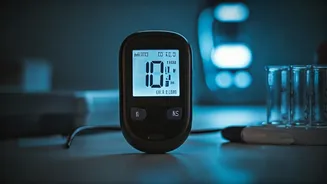Defining Type 2 Diabetes
Type 2 diabetes is a chronic health condition where the body either resists the effects of insulin or doesn't produce enough insulin to maintain normal
glucose levels. Insulin, a hormone made by the pancreas, acts like a key, allowing sugar (glucose) from food to enter cells for energy. When this process is disrupted, glucose builds up in the bloodstream. While genetics can play a role, lifestyle choices significantly influence the development and management of this condition. Regular monitoring of blood sugar levels is crucial for effectively managing the condition and preventing potential complications, which could arise from both high and low glucose levels over time. Awareness is the first step toward better health outcomes.
Normal Blood Sugar Levels
Understanding the target blood sugar ranges is fundamental for people living with Type 2 diabetes. Generally, the American Diabetes Association (ADA) suggests that for most adults with diabetes, the target before-meal blood sugar level should be between 80 to 130 mg/dL (milligrams per deciliter). Two hours after the start of a meal, the level should ideally be less than 180 mg/dL. These numbers may vary based on individual circumstances and advice from healthcare providers. It is important to note that these guidelines are general and not one-size-fits-all, as individual goals can differ based on factors like age, other health conditions, and pregnancy.
High Blood Sugar Explained
High blood sugar, or hyperglycemia, happens when there is too much glucose circulating in the blood. For people with Type 2 diabetes, a fasting blood sugar level consistently above 130 mg/dL or a post-meal blood sugar level frequently above 180 mg/dL may indicate hyperglycemia. Symptoms can include increased thirst, frequent urination, blurred vision, fatigue, and slow-healing sores. Long-term, uncontrolled high blood sugar can lead to serious health problems like heart disease, nerve damage (neuropathy), kidney damage, and vision loss. Regular monitoring of blood sugar levels, along with adherence to a prescribed treatment plan, is crucial to prevent and manage hyperglycemia.
Low Blood Sugar Effects
Low blood sugar, or hypoglycemia, is a potentially dangerous condition where blood glucose levels drop too low. It's often defined as a blood sugar level below 70 mg/dL. Symptoms of hypoglycemia can include shakiness, sweating, anxiety, confusion, dizziness, and even loss of consciousness. The quick consumption of fast-acting carbohydrates, like glucose tablets or juice, can help to raise blood sugar levels quickly in the case of hypoglycemia. Severe or repeated episodes of hypoglycemia can be harmful, so swift treatment and prevention strategies are essential for people living with Type 2 diabetes, often including adjustments to medication, meal planning, and exercise routines. Always consult a healthcare provider for personalized recommendations.
Diagnosis and Monitoring
Diagnosis of Type 2 diabetes typically involves blood tests that measure blood sugar levels. These may include a fasting blood glucose test, an A1c test (which measures average blood sugar over the past 2-3 months), and sometimes a glucose tolerance test. Regular monitoring is essential, and this is done by using a blood glucose meter or a continuous glucose monitor (CGM). Monitoring helps people with Type 2 diabetes to track their blood sugar levels throughout the day. This helps them understand how food, exercise, and medication affect their blood sugar. The frequency of monitoring is set by a health care provider to match individual needs and treatment plans.
Management Strategies
Effective management of blood sugar in Type 2 diabetes involves a combination of lifestyle changes and medical interventions. Diet plays a critical role, emphasizing whole foods, fiber-rich choices, and portion control. Regular physical activity increases insulin sensitivity and helps cells take up glucose. Oral medications or insulin injections may be prescribed to help lower blood sugar. Regular check-ups with healthcare professionals are key to adjusting the treatment plan as needed. Education and support from a diabetes care team, including a doctor, nurse, and possibly a dietitian, are very important for achieving optimal blood sugar control and improving overall health.












